Here’s a brief look at the Minolta AF 28-70mm F/2.8 G zoom lens. Scroll down for the main review.
|
Lens
|
Minolta AF 28-70mm F/2.8 G
|
|
Box contents
|
Front and rear caps, hood, case and users manual.
|
|
Cost
|
|
|
Build quality
|
Very good
|
|
Additional information
|
|
Specifications below
|
|
|
Optical configuration
|
16 elements in 11 groups
|
|
Angle of view
|
75°-34° full frame, 50°-23° APS-C.
|
|
Aperture
|
9 blades, circular
|
|
Full frame and APS-C
|
Yes, full frame and APS-C. APS-C equivalent, 42-105mm
|
|
Depth of field and focus scales?
|
Distance window.
|
|
Minimum focus, image plane to subject
|
31″ (787mm)
|
|
Minimum focus, end of lens barrel to subject
|
24.5″ (622mm)
|
|
Hard stop at infinity focus?
|
Yes |
|
Length changes when focusing?
|
Yes
|
|
Focus ring turns in AF?
|
Yes
|
|
Filter size
|
72mm
|
|
Filter ring rotates?
|
No
|
|
Distance encoder?
|
No
|
|
Max magnification
|
0.09x
|
|
Min. F/stop
|
F/22
|
|
Sony teleconverter compatible?
|
No
|
|
Length changes when zooming?
|
No
|
|
Dimensions WxL (my measurements)
|
3.3″ x 4.5″ 83mm x 114mm
|
|
Maximum extended length (my measurements)
|
4.57″ (116mm)
|
|
Weight bare (my scale)
|
29.8oz (846g) 30.8oz (873g) with caps
|
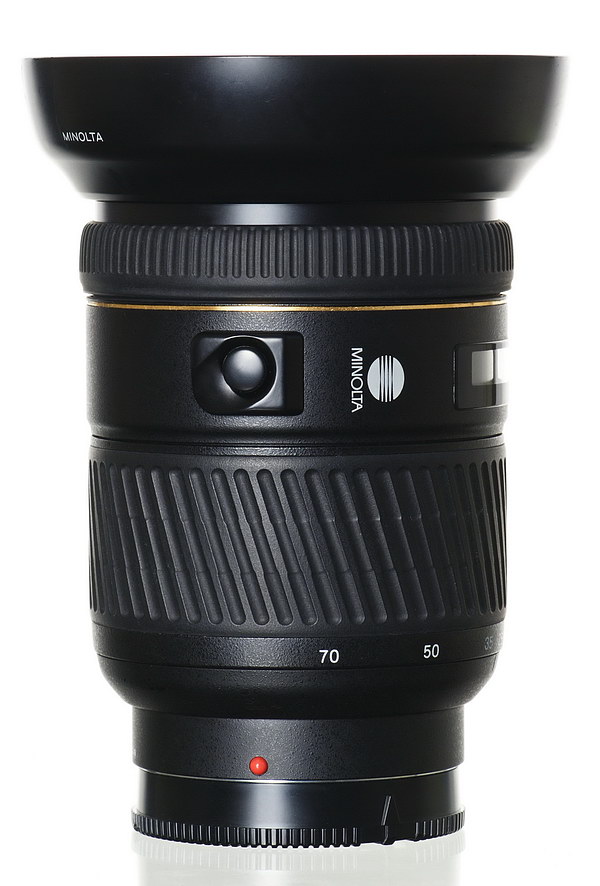 |
| Side view with focus stop button and factory hood |
 |
| Side shot once again without hood. |
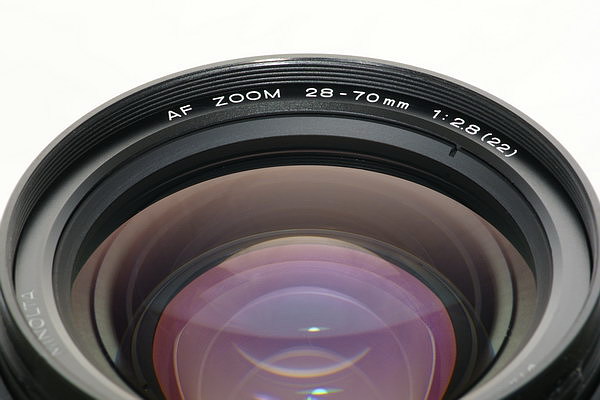 |
| Zoom at 45mm, notice front element near top. |
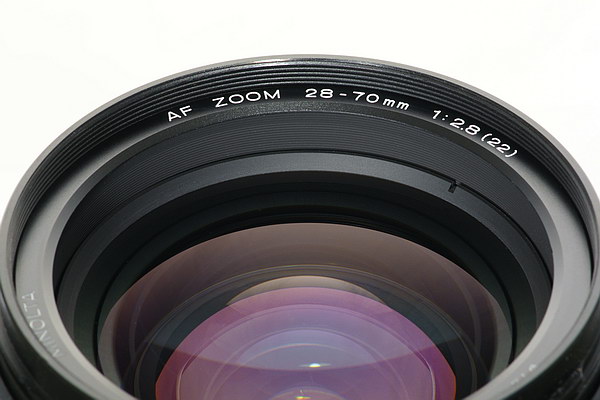 |
| Zoom at 28mm or 70mm, front element lower. |
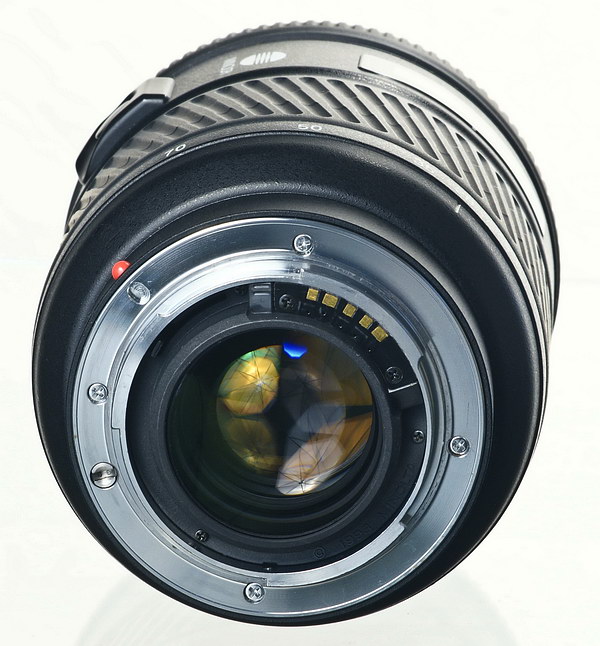 |
| Backside. |
 |
| Front element showing flare cut diaphragm in front of real aperture. |
The
Sony A700 and
Sony A900 were used for this review. For full frame results, go to the bottom of the page. For a better understanding of my review methods and terminology,
go here.
The (made in Japan) Minolta AF 28-70mm F/2.8 G is a professional grade lens (large, heavy and expensive) meant for people on the street, such as news photographers and Paparazzi. The “G” designation is on the box only, and never appears on the lens. Sony put an end to that modesty policy and started putting the “G” on its lenses in 2006. This lens was introduced back in the early 1990s so it has the re-styled look similar to the short-lived Konica Minolta lenses in the mid 2000s.
This wide to medium range zoom is large and heavy compared to other lenses covering this length. It has a constant fast aperture of F/2.8 with an internal zoom, (see images above), so it doesn’t extend out, or change length when you zoom. Currently, Sony has a lens similar to this one, the Carl Zeiss 24-70mm F/2.8. The color and texture of the Minolta matches the Sony camera bodies near perfectly. The zoom ring is not dampened equally along the rotation, so it’s either about right to slightly loose at any given time. You can one-finger it if that’s your style. Since it’s loose, it exhibits zoom creep, and pointing it straight up at 70mm runs it down to 60mm, and pointing it down at 60mm runs it back to 70mm. It has a focus distance window along with a single focus hold button, which can be changed to DOF on select camera bodies. The EXIF data matches up with the focal length marks, which come at 28mm, 35mm, 50mm, and 70mm. Increments are 5mm apart (after 30mm) in the data, but 65mm is missing, that’s the way it is. 50mm covers about a 1/4 of the zoom ring, but that’s no big deal. The lens is multi-coated with the magenta/blue/green look typical for the 1990s. Minolta also claims the use of two aspherical elements in the construction of the lens. This lens has a flare cut diaphragm, (Minolta uses the term “moving mask”) but don’t equate this with good flare and ghosting control, see issues below.
Auto-focusing is somewhat slow and noisy, but that’s normal for the era in which it was built. It seems pretty accurate though, and I had no problems with locking focus, even at F/2.8 in poor light. Manual focusing takes just over 1/5 turn from Close-in to infinity, with a little back slop, but not bad. The filter ring extends as you focus, (not to be confused with the focus ring) which is at the end of the lens barrel, and only adds a couple of millimeters to the overall length.
Lens flare/ghosting. Poor. Check out the samples below. If the sun is near the image, you’ll need to block it with your hand, since the included lens hood is inadequate, and was designed wrong by Minolta engineers, then again it may have been economics, but on a $1000 lens?. If you add about an inch (25mm) to the hood, it does a much better job at blocking stray light, and causes no vignetting. You may want to try a rubber screw-on type and trim it to fit. If the sun is in the image, you’re
SOL. If you like taking pictures with the sun in the image, use the Sony kit lens, which has the best control of flare and ghosting of any zoom I’ve tested. The Minolta AF 28-70mm F/2.8 G lens has a flare cut diaphragm, (see product shot image where it’s closed), which opens and closes like a regular aperture, but this one is controlled by the zoom. It’s located outward of the normal aperture and closed to its fullest extent at 28mm, (though really not entirely closed because you need light), then slowly opens all the way by 55mm. It’s supposed to help control reflections at wide angle, but I’m not sure how much it’s helping here.
Color fringing. Very good control here, though look for some axial CA, which goes away as you stop down. See 70mm center shots below. It is not a problem by any stretch. I see some lateral CA under extreme conditions, but overall the lens performed well here.
Bokeh. Good at normal viewing and print sizes, see crops below. Background blur is best at F/2.8, but as you stop down things start to go south. Neutral when examined at 100%.
Color. Similar to other Minolta AF lenses.
Coma. Extremely light at F/2.8, gone by F/3.5. Full frame is different though.
Close-up filter. N/A.
Filter size is 72mm. This size is not used very much in the Sony lineup, except some specialty lenses such as the Sony 135mm F/2.8 STF, CZ 85mm F/1.4 and the Sony 20mm F/2.8.
Normal filters cause very slight corner darkening on full frame results, F/2.8 @ 28mm, but none on APS-C cameras.
Distortion. See below. Barrel at 28mm, but almost mild. Distortion is flat at 45mm-50mm, then it turns to mild to moderate pincushion. Fairly good control here.
Distortion examples
 |
| 28mm, mild to moderate barrel distortion. |
 |
| Mild to moderate pincushion at 70mm. |
|
Ghosting, 28mm F/5.6
|
Sun in picture shot, 28mm F/5.6
|
|
|
|
|
Minolta 28-70mm, 28mm F/11
|
Same shot with Sony kit lens at F/11
|
|
|
|
|
Bokeh, 28mm F/2.8
|
Bokeh, 28mm F/4
|
|
|
|
|
Bokeh, 70mm F/2.8
|
Bokeh, 70mm F/4
|
|
|
|
Full image extreme samples of flare/ghosting above, but they show actual results near the sun. Poor control at all focal lengths. In the top left shot the sun was just outside the frame. The two lower shots compare the cheap little Sony 18-70mm kit lens with the $1000 G lens. If you like taking pictures with the sun in the frame, use the kit lens, which is the best zoom I’ve reviewed at controlling flare and ghosting. When taking pictures with the sun just outside the frame, use your hand instead of the supplied hood which was improperly designed by Minolta Engineering minions. The hood could have been moved out about an inch (25mm) resulting in much better control of flare and ghosting without any vignetting. Maybe it was an economic thing. I put those shots in to show the doubters it’s possible to get a good shot by shooting into the sun. Bokeh examples above, pretty smooth at F/2.8 across the zoom, but it gets a little harsh as you stop down. Samples where taken from the central background area of the image, about 15ft (4.6m) behind the subject, and cropped at 100%.
Light fall-off.
Light fall-off or corner shading is mild at F/2.8 from 28mm to 70mm, one stop down and it’s gone. No problems on a cropped sensor camera, but see full frame results at the bottom of the page.
|
28mm F/2.8
|
28mm F/4
|
|
|
|
|
70mm F/2.8
|
70mm F/4
|
|
|
|
Center and corner sharpness.
Below are crops from the image centers at 28mm.
Now the 28mm corner crops.
The 28mm center crops show very little improvement by stopping down, that’s good. There’s a hint of contrast loss at F/2.8, but the image is still sharp. At F/4 everything looks great. The 28mm corners look the same as the centers, again, very good. The exposure differences are from light fall-off.
Below, look at the 70mm centers.
|
70mm F/2.8
|
70mm F/4
|
|
|
 |
|
70mm F/5.6
|
70mm F/8
|
|
|
 |
|
70mm F/2.8
|
70mm F/4
|
|
|
 |
On to the 70mm centers, where the results are pretty much the same as the wide angle shots, pretty sharp at F/2.8, then maybe a hair sharper one stop down, but only visible blown way up on a computer screen. I see a tiny bit of contrast loss at F/2.8, and some axial color fringing which goes away as you stop down. It’s very minor and not something that is visible unless viewed at large sizes as I said above. Keep in mind the full images would print out at 45″ (1.14m) long as they appear in the crops using an A700. The corners really aren’t helped by closing the aperture, you just see some light fall-off at F/2.8. The entire image is nice and sharp with an APS-C camera no matter what the focal length or aperture. It doesn’t get much better than this.
Let’s check out the
macro capabilities of this lens.
Below, check out the sample, it’s small, (so no link to larger size), and also a 100% cropped portion of the full image. The sample shot was taken with the
Sony A 700 12.2MP camera. The subject is a standard US stamp, 1″x 3/4″ or 25.4mm x 19mm. Also, note the macro shot was taken as close to the subject as focusing allowed; in this case a rather lengthy 24.5″ (622mm), measured from the front of the lens barrel to the subject.
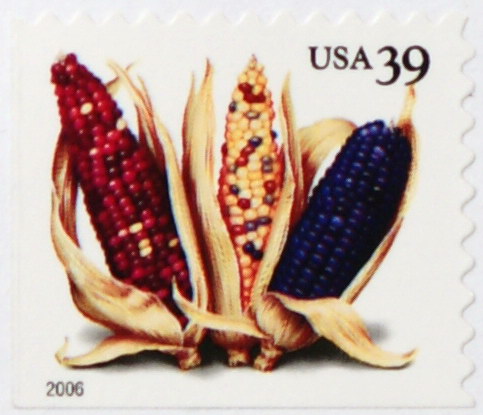 |
| As close as you can get, F/4. |
The Minolta AF 28-70mm F/2.8 G has a poor reproduction ratio, only 0.09x, so you’re out of luck if you want some close ups of small items. This shot was taken at F/4, but there was little difference between that and F/11. F/2.8 looks soft with test charts, but looks fine in real pictures.
Full frame results using the Sony A900 below.
Check out the differences when using a film or full frame camera below. I’m only pointing out the noticeable issues as compared to the APS-C bodies, so if I don’t show it here, the results are not significantly different enough to warrant posting an additional set of images in this section.
Light fall-off
|
28mm F/2.8
|
28mm F/4
|
 |
 |
|
28mm F/5.6
|
28mm F/8
|
|
|
|
|
70mm F/2.8
|
70mm F/4
|
|
|
|
Light fall-off is worse than the APS-C crops shown earlier. At 28mm, F/2.8 it shows heavy, but isn’t all that noticeable in real shots, see image below. Also, when using a regular filter, (not thin) the corners are slightly darker wide open at 28mm.
Full image from A900 below.
The rather boring backyard scene above illustrates a couple of points about this lens. First, light fall-off with a wide open aperture isn’t all that noticeable in real pictures, two, notice the nice background blur at 28mm, F/2.8, which doesn’t show the soft corners that everyone cries about in chat rooms. In a daylight outdoor scene, you could isolate the subject as I’ve done here, or stop down to F/8-11 and sharpen up the entire scene, so either way I wouldn’t have to worry about problems with soft corners and light fall-off.
28mm corner samples next.
|
F/2.8
|
F/4
|
 |
 |
|
F/5.6
|
F/8
|
|
|
|
The corners are softer than the APS-C crops show. Things sharpen up nicely at F/5.6, then max out at F/8. The centers of these crops are about 250 pixels from the image borders, which would darn near be covered up by a picture frame with a medium sized print. The exposure differences are from light fall-off.
70mm corners below.
|
F/2.8
|
F/4
|
 |
 |
|
F/5.6
|
F/8
|
|
|
|
The 70mm corners don’t change much, you mostly see the elimination of light fall-off. Things sharpen up a little as you stop down, but not much, and there isn’t much difference between the images above, and the APS-C shots.
Distortion next.
 |
| Barrel distortion @ 28mm on A900 |
 |
| Pincushion distortion @ 70mm on A900 |
There is moderate to slightly heavy distortion at both ends on the A900, but not enough to be noticeable unless you’re shooting horizons or buildings. You’ll also notice the barrel distortion pattern is complex, showing a rise in the middle, then falling off hard towards the sides. This requires extra effort to straighten in post-processing. Pincushion is a gentle curve and easy to fix.
Coma results with full frame.
|
F/2.8
|
F/4
|
 |
 |
This is coma @ 28mm on the A900. It looks like fighter planes! It isn’t too bad at F/2.8, one stop down and it’s almost gone. It doesn’t clear up very much as you zoom out, and results are mostly the same up to 50mm. Everything looks pretty good from 50-70mm. The 100% crops in this A900 section are from the extreme corners and are a portion of the original image. Printing out the entire image as you might see it on your screen would measure 65″ (1.65m) wide!
|
Conclusion.
For APS-C users; the Minolta AF 28-70mm F/2.8 G lens performs very well at all focal lengths and apertures. The corners are nearly as sharp as the centers, even at F/2.8. Light fall-off and coma are almost non-existent. There are two drawbacks though, flare and ghosting control is poor, so watch out when the sun is near the image, solve this by using your hand to block the light. When the sun is part of the image, you’re going to have a mess. The 35mm equivalent for this lens is 42-105mm. If you aren’t really in to wide-angle type shots, this would be a great lens, although it’s pretty expensive. For people wanting the same basic focal range in a new lens, though not quite as fast, consider the excellent
Carl Zeiss 16-80mm F/3.5-4.5 as a less expensive alternative.
For full frame users; you’ll have the same basic problems with flare and ghosting, though it’s not noticeably worse. Light fall-off, corner sharpness, distortion and coma are slightly stronger, but that’s not a big deal as you saw above. If you really need to use F/2.8, and want a smooth bokeh (at F/2.8), this lens may be worth a look. It’s great for indoors and people shots, and is currently selling for only half the cost of the
new CZ 24-70mm F/2.8 lens from Sony.

















































